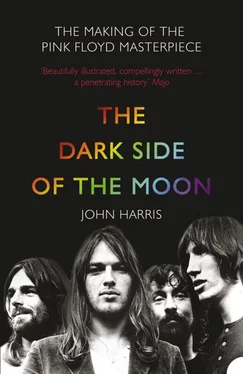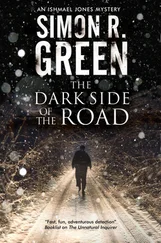For all Smith’s trials, in Peter Jenner’s estimation, he pulled off a commendable artistic feat: teasing out Barrett’s sense of pop aesthetics from the instrumental tangle that defined Pink Floyd’s performances. ‘What he did,’ says Jenner, ‘was to say, “Well, you’ve written these jolly good pop songs – so let’s have those, and some weird instrumental breaks.” So instead of being blues songs with weird instrumental breaks, it became pop songs with weird instrumental breaks.’
Notice of the abiding idea was served by the opening track, ‘Astronomy Domine’: from Barrett’s supremely sinister opening growl of guitar, it is obvious that havoc is about to be played with the period’s standard musical norms, but the song’s exploratory, improvisational core is book-ended by passages that betray both a tight sense of musical control, and an intuitive grasp of the melodic demands of pop. Even ‘Interstellar Overdrive’, the instrumental mission-statement that found the spirit of their live shows being poured on to tape, is ultimately a showcase for the group’s ability, having let loose chaos, to purposefully rein it back in. For all the lysergic abandon that takes root inside its first minute – punctuated by the kind of musical tension that Aubrey Powell found so compelling in the band’s live shows – its central riff is the essence of both control and streamlined strength: certainly, when it gloriously re-enters the picture after eight and a half minutes, one gets a sense of the band single-mindedly returning to earth.
Piper ’s other most notable aspect was Barrett’s lyrics. Whereas the music betrayed both power and sophistication, his words were recurrently grounded in the fragile simplicity of childhood, often so innocently expressed that one cannot help but arrive at a crude explanation for Barrett’s breakdown. How, it might be asked, could the kind of mind that came up with ‘The Gnome’ (‘Look at the sky, look at the river – isn’t it good?’), or the rose-tinted memoir ‘Matilda Mother’ – a loving remembrance of Winifred Barrett reading her son fairy-tales – adapt to the hard demands of adulthood, let alone the pressures that arrive in the wake of commercial success? Rock music, even then, was only partly founded on talent and creativity; if a musician was to survive, he or she also needed wiliness, resilience, and determination: in short, a keen sense of ambition.
‘Syd was a real hippie in a lot of respects,’ says Aubrey Powell. ‘If he had a guitar, and he could play some tunes, and sing some of his wonderful bits of poetry, and somebody could supply him with a nice space where he could play his Bo Diddley albums, that was enough. Even when he was earning money, Syd wasn’t living extravagantly. He was quite happy to live in a flat with no furniture in it. He was a real bohemian in that sense. I never felt he was pop star material; he wasn’t made for it.’
The Piper at the Gates of Dawn was preceded by ‘See Emily Play’, which thrust Pink Floyd into dizzying territory, climbing to number six on the British singles charts, and confirming the necessity of endlessly touring the country so as to prolong their success. By the time of its release, however, Syd Barrett was beginning to fall apart. ‘He became steadily more remote,’ says Peter Jenner. ‘He was hard to talk to. From being occasionally withdrawn, he got very strange . And his life became more and more his own life until we hardly saw him. That was when I really began to worry that there was something going seriously awry.’
Most of the songs on Piper had been written during a concerted burst of creativity in late 1966 and early 1967, when Barrett was living in an apartment on Earlham Street in central London. In the recollection of his flatmate, the group’s lighting technician Peter Wynne-Wilson, ‘Those were halcyon days. He’d sit around with copious amounts of hash and grass and write these incredible songs. There’s no doubt they were crafted very carefully and deliberately.’
By April 1967, Barrett had shifted his base of operations to 101 Cromwell Road, an address in Earls Court. Among the residents was one Brian ‘Scotty’ Scott, remembered by one Pink Floyd associate as ‘one of the original acid-in-the-reservoir, change-the-face-of-the-world missionaries’. For Barrett, the upshot of such company was clear enough. ‘He seemed to be on acid every day,’ says Peter Jenner. ‘We heard he was getting it in his tea every morning.’ This, it was safe to say, was hardly the ideal lifestyle for someone whose sensibilities were proving ever more fragile, but for the moment, neither the band nor their associates saw fit to intervene.
‘Everything was coming at us from all directions,’ says Jenner. ‘In the early days, when Syd was at Earlham Street, I’d just pop round there quite often and see him. As they became bigger, he moved into his own social scene. We saw less of him; he became more distant. We realized there was something strange going on in Cromwell Road, but I didn’t know the people who were there. And I never really felt it was my job to find out. It was only when it became clear that there was a problem with gigging – with work … In those days, it was really uncool – man – to pry into someone’s life.’
When the group and their associates attempted to deal with Barrett’s predicament, they initially did so in the context of a quintessentially 1960s invention known as anti-psychiatry, one of the many strands of thought beloved of the upper echelons of the Underground. Relative to the other credos of the period, it was a neat fit: just as underground insiders like Richard Neville believed that the key to social change lay with the moral and emotional liberation of the individual, so anti-psychiatry held that the shortcomings of twentieth-century civilization were reflected in isolated cases of supposed mental breakdown. The key pioneer of all this was a Scottish doctor named R. D. Laing, born in 1927, but sufficiently radical in his outlook to be co-opted into the Underground by his younger admirers.
Laing was fleetingly involved in the Notting Hill Free School, became a regular presence at Underground events, and was decisively tied into the mood of 1967 by that year’s publication of a polemic, drawn from his lectures, entitled The Politics of Experience . Schizophrenia, the book claimed, arose from a rational desire to opt out of impossible circumstances: ‘The experience and behaviour that gets labelled schizophrenic is a special strategy that a person invents in order to live in an unlivable situation.’ Moreover, the supposed schizophrenic might actually be capable of greater insights and achievements than the allegedly sane: in Laing’s view, asking whether the condition was wholly due to a deficiency on the part of the sufferer was ‘rather like supposing that a man doing a handstand on a bicycle on a tightrope 100 feet up with no safety net is suffering from an inability to stand on his own two feet. We may well ask why these people have to be, often brilliantly, so devious, so elusive, so adept at making themselves so unremittingly incomprehensible.’ Underlying all this was the belief that society so squashed individual potential that mental dislocation was inevitable. ‘The ordinary person,’ Laing wrote, ‘is a shrivelled, desiccated fragment of what a person can be.’
‘There were a whole team of them who all believed it was rather good to be mad, and it was the rest of us who were making less sense,’ remembers Roger Waters. ‘And it may be that there is something to be said for the idea that people who we claim to be mad might see things that the rest of us don’t, and their experience can illuminate life for us. He seemed to be thinking that insanity might be a very subjective idea; that perhaps madness might give people some kind of greater insight. In Syd’s case, you could say that it was his potential for decline into schizophrenia that gave him the talent to express mildly untouchable things. But I confess that I feel that a lot less now than I may have done then.’
Читать дальше












